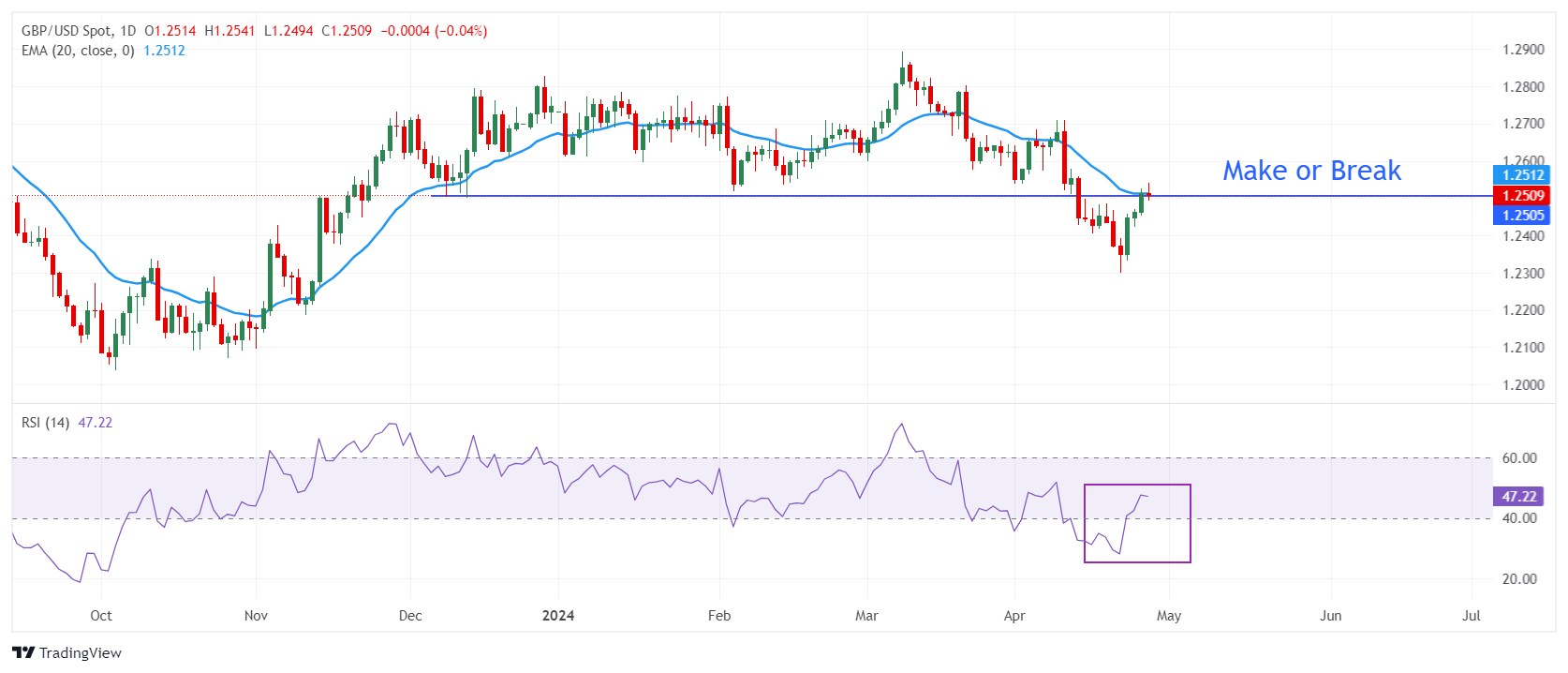- The Pound Sterling comes under pressure as the US Dollar rebounds due to hot US core PCE Price Index data
- US annual inflation grew at a higher pace of 2.7% against the consensus of 2.6%.
- Firm speculation for BoE rate cuts weigh on the Pound Sterling.
The Pound Sterling (GBP) faces selling pressure near 1.2500 against the US Dollar (USD) in Friday’s early American session. The GBP/USD pair drops as firm expectations that the Bank of England (BoE) will start reducing interest rates from the June meeting. BoE policymakers see inflation receding sharply in upcoming months but still refrain from providing a concrete time frame for interest-rate cuts. In the press conference after the last monetary policy meeting, BoE Governor Andrew Bailey said market expectations for two or three rate cuts this year are not “unreasonable”.
Meanwhile, the United Kingdom’s economic outlook has improved even though the Bank of England (BoE) is maintaining interest rates higher. The preliminary PMI report from S&P Global/CIPS for April, released on Tuesday, showed that activity in the services sector remains robust, pushing overall activity higher despite a lagging Manufacturing PMI. The data also showed that new business inflows in the service sector remain strong.
Higher demand for services tends to boost employment and wages in the sector, contributing to inflation pressures. This could stall progress in inflation easing to the desired rate of 2%. Also, BoE policymakers have remained worried about high service inflation. Currently, the UK annual service inflation is at 6%, higher than what is required to be consistent for bringing down inflation to the 2% target.
Daily digest market movers: Pound Sterling falls as US Dollar recovers
- The Pound Sterling struggles to hold strength near a ten-day high at around the psychological figure of 1.2500 against the US Dollar. The US Dollar rebounds as the US core Personal Consumption Expenditures Price Index (PCE) data for March remains hotter-than-expected.
- Annually, the underlying inflation grew at a higher pace of 2.7% from the estimates of 2.6% but remains lower than the former reading of 2.6%. On a monthly basis, the inflation data rose steadily by 0.3%.
- Stubborn inflation data could allow the Fed to maintain a hawkish rhetoric. Fed policymakers have been reiterating that interest-rate cuts are only appropriate when they are convinced that inflation will return sustainably to the 2% target.
- After the underlying inflation data, investors will focus on the Fed’s monetary policy decision, which will be announced on Wednesday. The Fed is widely anticipated to keep interest rates unchanged in the range of 5.25%-5.50%. Investors will keenly focus on the Fed’s guidance for interest rates.
- On Thursday, the US Dollar came under pressure after the preliminary United States Gross Domestic Product (GDP) growth in the first quarter turned out weaker than expected.
- The US Bureau of Economic Analysis (BEA) reported on Thursday that the economy expanded at a slower pace of 1.6% in Q1, below expectations of 2.5% and the prior reading of 3.4%. Despite the data miss, traders maintain strong bets for the Federal Reserve to start reducing interest rates from September or in the fourth quarter as the GDP Price Index was significantly higher. The inflation measure rose to 3.1% from the prior reading of 1.7%.
Technical Analysis: Pound Sterling faces resistance near 1.2500

The Pound Sterling trades near Thursday’s high at around 1.2500 against the US Dollar. The GBP/USD pair struggles to extend the upside above the 20-day Exponential Moving Average (EMA), which trades around 1.2510.
The 14-period Relative Strength Index (RSI) rebounds above 40.00, suggesting that a bearish momentum might have concluded for now. However, the long-term bearish bias remains intact.
A sustainable move above the psychological resistance of 1.2500 will drive the pair towards the 200-day EMA, which hovers around 1.2550. On the other side, a downside move below Wednesday’s low at around 1.2430 will expose GBP/USD to a five-month low at around 1.2300.
Vanliga frågor om risksentiment
I den finansiella jargongens värld hänvisar de två ofta använda termerna "risk-on" och "risk off" till den risknivå som investerare är villiga att tåla under den refererade perioden. På en "risk-on"-marknad är investerare optimistiska om framtiden och mer villiga att köpa riskfyllda tillgångar. På en "risk-off"-marknad börjar investerare "spela säkert" eftersom de är oroliga för framtiden och därför köper mindre riskfyllda tillgångar som är mer säkra på att ge avkastning, även om den är relativt blygsam.
Normalt kommer börserna att stiga under perioder av "risk-on", de flesta råvaror – förutom guld – kommer också att öka i värde, eftersom de gynnas av en positiv tillväxtutsikt. Valutorna i länder som är tunga råvaruexportörer stärks på grund av ökad efterfrågan och kryptovalutor stiger. På en "risk-off"-marknad stiger obligationer – särskilt stora statsobligationer – guldet glänser, och säkra tillflyktsortsvalutor som japanska yen, schweiziska franc och US-dollar gynnas.
Den australiska dollarn (AUD), den kanadensiska dollarn (CAD), den nyzeeländska dollarn (NZD) och mindre valutakurser som rubeln (RUB) och den sydafrikanska randen (ZAR), tenderar alla att stiga på marknader som är "risk- på". Detta beror på att ekonomierna i dessa valutor är starkt beroende av råvaruexport för tillväxt, och råvaror tenderar att stiga i pris under riskperioder. Detta beror på att investerare förutser en större efterfrågan på råvaror i framtiden på grund av ökad ekonomisk aktivitet.
De viktigaste valutorna som tenderar att stiga under perioder av "risk-off" är den amerikanska dollarn (USD), den japanska yenen (JPY) och den schweiziska francen (CHF). Den amerikanska dollarn, för att den är världens reservvaluta, och för att investerare i kristider köper amerikanska statsskulder, vilket ses som säkert eftersom det är osannolikt att den största ekonomin i världen kommer att gå i konkurs. Yenen, från ökad efterfrågan på japanska statsobligationer, eftersom en hög andel innehas av inhemska investerare som sannolikt inte kommer att dumpa dem – även i en kris. Schweiziska francen, eftersom strikta schweiziska banklagar erbjuder investerare ett utökat kapitalskydd.
Source: https://www.fxstreet.com/news/pound-sterling-holds-gains-ahead-of-us-core-pce-inflation-202404260832